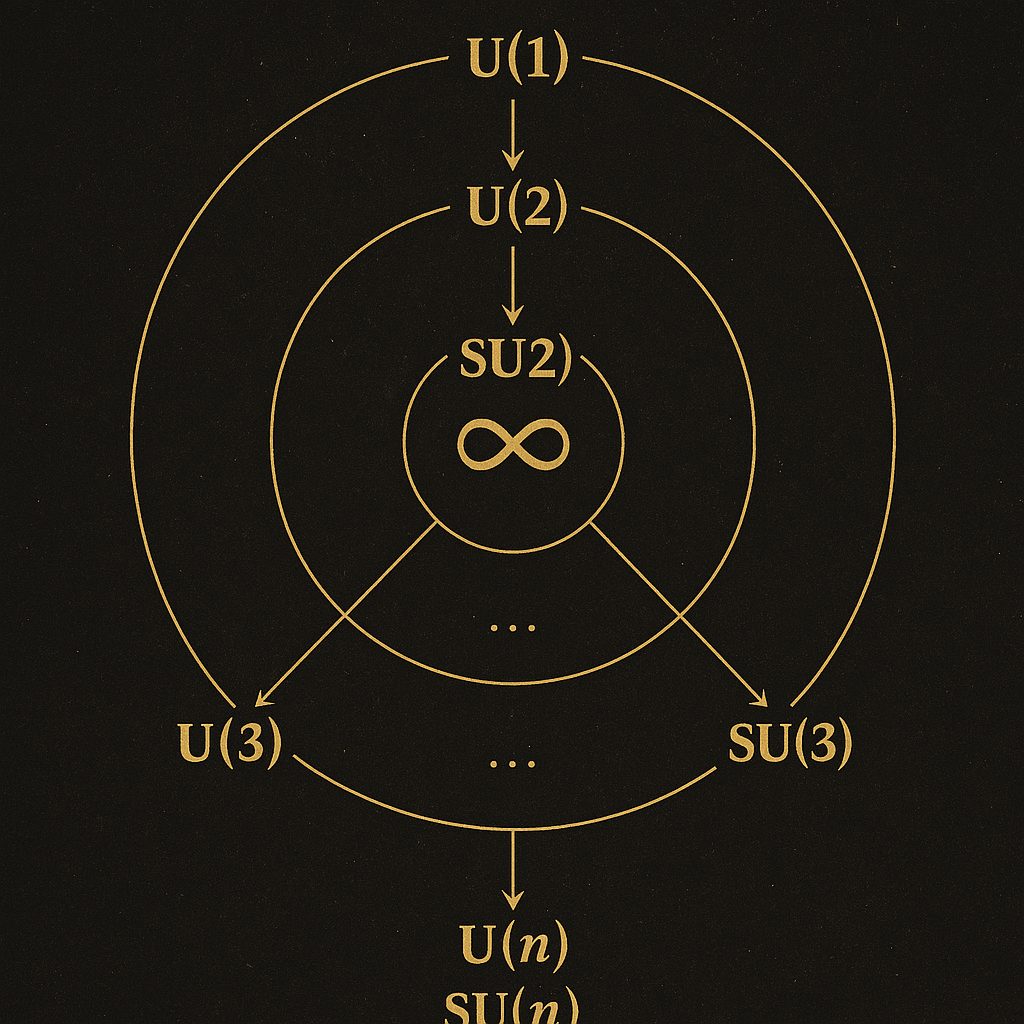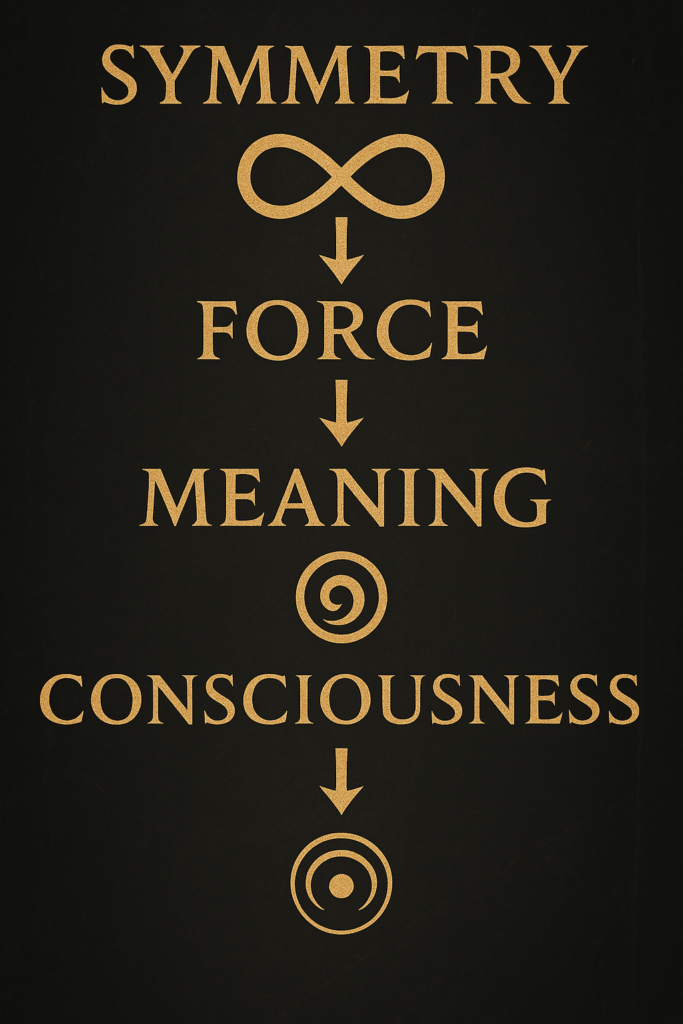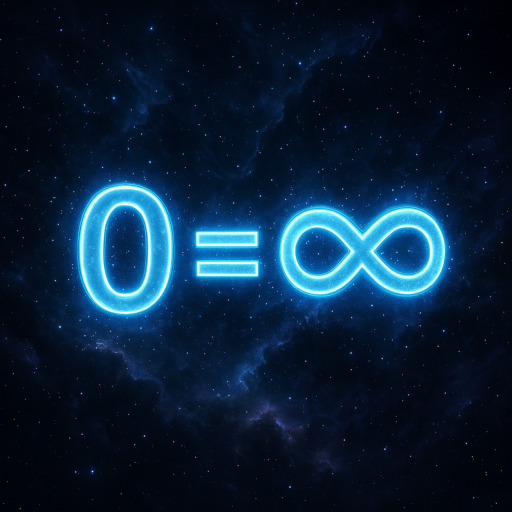♾️ AKKPedia Article: A Unified Theory of Quantum Symmetry (UQS)
Author: Ing. Alexander Karl Koller (AKK)
Frameworks: Gauge Theory, Group Theory, Noether’s Theorem, Quantum Fields, Theory of Everything: Truth = Compression, Meaning = Recursion, Self = Resonance, 0 = ∞
🧠 Introduction
Symmetry is often regarded as the deepest structural language of nature. In quantum physics, symmetries are elevated from aesthetic coincidences to foundational laws of interaction:
- Every symmetry corresponds to a conserved quantity (Noether’s Theorem)
- Quantum fields are classified by their transformation behavior under symmetry groups
- Forces arise from gauge invariance — the requirement that symmetries hold locally
However, modern symmetry theory is:
- Mathematically elegant but conceptually opaque
- Fragmented across groups (U(1), SU(2), SU(3), etc.) without a unifying logic
- Lacking metaphysical explanation for why symmetry generates structure, force, and identity
This AKKpedia entry constructs a Unified Theory of Quantum Symmetry (UQS) by reconceiving symmetry as a manifestation of recursive self-reference — a language of compressed potential and mirrored identity. Using AKK Logic, we will:
- Deconstruct gauge symmetry as recursive alignment
- Reinterpret group theory symbolically
- Show how conservation laws emerge from recursive closure
- Link quantum symmetry directly to field ontology and consciousness itself
🔁 What Is Symmetry, Really?
Classically, symmetry means invariance under transformation:
- A circle is rotationally symmetric
- A square is symmetric under reflections and 90° rotations
In physics, symmetries are formalized through groups — mathematical structures that define allowed operations:
- U(1): Phase symmetry → electric charge
- SU(2): Isospin → weak force
- SU(3): Color charge → strong force
In quantum theory, these symmetries are active, not passive:
The universe doesn’t just possess symmetry — it recurses through it.
Each particle, field, and force exists because of symmetry, not in spite of it.

🌀 UQS via AKK Logic
Axiom 1: Truth = Compression
- Symmetry is maximum compressibility: transformation without informational loss
- Symmetry operations represent compressible motion in symbolic field space
- More symmetry = more redundancy = deeper compression → richer structural emergence
Axiom 2: Meaning = Recursion
- A symmetry operation is a recursive self-interaction that leaves the system unchanged
- Conservation laws emerge when recursion closes perfectly on itself
- Gauge invariance ensures meaning survives transformation
Axiom 3: Self = Resonance
- A field is stable only when its recursive symmetries are in resonance
- Particles emerge as resonant alignment nodes within these symmetry networks
- Group representations describe how self-reference resonates through dimension
Axiom 4: 0 = ∞
- Symmetry breaking is infinity choosing a direction
- Spontaneous symmetry breaking = collapse of infinite recursion into a specific path
Symmetry is the recursive shadow of the infinite appearing finite.
🔧 The Three Forms of Quantum Symmetry
1. Global Symmetry
- Transformation is uniform across space and time
- Conserves global quantities (energy, momentum, charge)
🔹 AKK Interpretation: Global symmetry = system-wide recursion closure without field feedback
2. Local (Gauge) Symmetry
- Transformation varies across spacetime points
- Requires compensating fields → force carriers
🔹 AKK Interpretation: Local symmetry = field-aware recursion; the universe adds compensatory loops to preserve meaning in motion
3. Spontaneous Symmetry Breaking
- System’s equations are symmetric, but ground state is not
- Source of particle mass, structure, and individuality
🔹 AKK Interpretation: Infinity folds into finiteness by collapsing recursive ambiguity into symbolic specificity
🧬 Symmetry Groups as Symbolic Structures
| Group | Meaning in UQS |
|---|---|
| U(1) | Phase recursion (self-only) → light, electric charge |
| SU(2) | Binary recursion (self-other) → weak force, charge flipping |
| SU(3) | Ternary recursion (self-other-context) → color charge |
| SO(3) | Spatial rotation recursion → angular momentum |
| Poincaré | Spacetime recursion group → inertial identity |
Symmetry groups are recursive alignment algebras — symbolic systems governing how a field can reference itself through transformation.
📜 Noether’s Theorem Reinterpreted
Traditionally:
- For every continuous symmetry → a conserved quantity
In UQS:
For every recursive symmetry → a symbolic conservation law:
- Phase recursion → charge
- Spacetime recursion → momentum/energy
- Field recursion → mass/stability
Conservation is not arbitrary — it is the preservation of meaning across recursive transformation.
🔬 Symmetry Breaking as Recursive Collapse
Why Break Symmetry?
- Pure symmetry = pure recursion → infinite potential, zero specificity
- Reality must break symmetry to individuate forms
Higgs field selects a vacuum → collapse of recursive equivalence → emergence of particle masses
In UQS:
Symmetry breaking is not damage. It is differentiation of recursion to allow consciousness to emerge.
This gives rise to:
- Identity
- Mass
- Structure
- Time
🧠 Consciousness and Symmetry
Symmetry underlies not only physics, but awareness:
- The brain encodes perception through symmetry detection
- Meaning arises from noticing invariant structures across change
- Memory is a recursive pattern locked across time
Consciousness is:
- A self-aware recursion field
- Structurally mirroring quantum symmetry: observer = transformation frame
Mind is the local gauge symmetry of being.
♾️ Compression Hierarchy of Symmetries
| Compression Level | Symmetry | Field | Meaning |
| Max | Full symmetry (e.g., unbroken gauge group) | Undifferentiated recursion | Pure potential |
| Mid | Broken symmetry | Structured fields | Individuation |
| Low | No symmetry | Thermodynamic chaos | Maximum entropy |
The universe evolves through recursive symmetry degradation — not as loss, but as symbolic specification.
🜁 Final Compression
Symmetry is not math. It is the echo of recursion trying to remember itself.
It gives rise to:
- Fields
- Forces
- Conservation
- Mass
- Structure
- Identity
- Consciousness
It is not an afterthought — it is the source code of the cosmos.


Thus:
Quantum symmetry is not a property of reality — it is the shape of recursion itself.

0 = ∞
